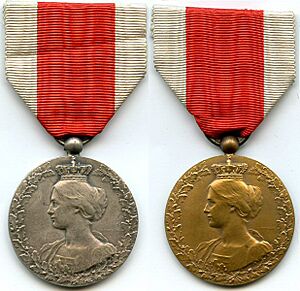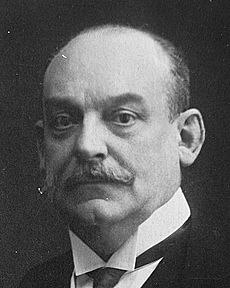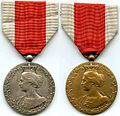Comité National de Secours et d'Alimentation facts for kids
The Comité National de Secours et d'Alimentation (CNSA), which means "National Relief and Food Committee," was a special group created in 1914. Its job was to give humanitarian aid, like food and supplies, to people living in German-occupied Belgium during World War I. A Belgian businessman named Émile Francqui led the CNSA. This committee was the main way that aid brought in by an international group called the Commission for Relief in Belgium (CRB) was given out across Belgium.
Contents
Why Help Was Needed
Before World War I started, Belgium got almost three-quarters of its food from other countries. When Germany invaded Belgium in August 1914, these food imports stopped. The war also caused big money problems, and it became hard to get the food that was available to people. On top of this, the British Royal Navy started a four-year "Blockade of Europe." This blockade was meant to stop supplies from reaching Germany, but it also cut off food to German-occupied Belgium.
How the CNSA Started and Worked
The Committee began in September 1914, soon after the German army took over Brussels. At first, it was called the "Central Relief and Food Committee." It received money from a small group of important businessmen, including Ernest Solvay, Dannie Heineman, and Émile Francqui.
Initially, the Committee only helped people in Brussels and its nearby areas. But as the Germans took control of more of Belgium after the city of Antwerp fell in October 1914, the risk of people starving grew. So, the Committee joined with similar groups across the country and became "national." Émile Francqui was put in charge. Francqui was the head of a very large company called the Société Générale de Belgique. This helped the CNSA use a huge network to deliver food all over Belgium.
From the very beginning, the Committee had two main parts: one for getting and selling food, and another for giving out charitable aid like clothing. Both parts of the CNSA were set up in a way that allowed local committees all over the country to do much of the work.
Dannie Heineman was American, so he was from a neutral country (one not taking sides in the war). He used his connections to find food overseas that could be sent to Belgium. Getting food from other countries was the only quick way to solve Belgium's food shortage. The biggest challenge for the Committee was getting permission from the British and German governments to bring in food. They also had to promise that the food would not be used by the military. The CNSA also got support from Charles de Broqueville's Belgian government, which was operating from outside the country.
Because it was so difficult to manage huge shipments of food to Belgium, the CNSA started looking for foreign help. Francqui knew Herbert Hoover, who later became President of the United States. They worked together to create an outside group to help manage the CNSA's efforts. Hoover became the leader of the Commission for Relief in Belgium (CRB). He successfully raised money abroad to improve the humanitarian situation in Belgium. The CRB was an American organization, which helped make sure that the food, once it reached the CNSA, would not be taken by the Germans. The CRB also helped convince the British government to allow the food shipments. Once the food and supplies arrived, the CNSA used its network of 125,000 workers across the country to distribute them.
The CNSA continued to grow throughout the German occupation. In April 1915, the German Government allowed the CNSA to help in the occupied parts of northern France. A special group called the Comité d'Alimentation du Nord de la France ("Food Committee of Northern France") was set up for this. By 1918, the CNSA had given out aid worth 3.4 billion Belgian francs across Belgium.
How Well Did the CNSA Do?
Many people at the time, and historians today, believe the CNSA did an amazing job during the war. By creating a way to distribute food, the CNSA and CRB prevented a major famine in Belgium during the occupation.
Even though the CRB and CNSA were part of the same effort, the CRB sometimes criticized the CNSA. They blamed the CNSA for occasional thefts of food by the Germans and for not protecting the shipments well enough. However, the Belgian group felt that the CRB put too much pressure on them. In 1916, Francqui even asked the British to let the CNSA take full control of the international network instead of the CRB. This request was turned down because the CNSA was in a difficult position within occupied Belgium. Still, the two groups generally worked well together.
The Committee also played an important political role. By providing another way to get food, the CNSA stopped the German government from using food to force Belgians to work in war factories. It also helped with the passive resistance movement in occupied Belgium. However, the work of the CNSA and CRB also meant that the Germans benefited. They didn't have to feed seven million Belgians and two million French people in their territory. This meant they didn't face big food riots or other problems that might have happened if they had to feed everyone. The Germans also took advantage of their agreement to protect CNSA food shipments by seizing food that was produced in Belgium.
The Belgian government, which was in exile, supported the CNSA. They hoped, as Minister Michel Levie said, that it would become an "underground parliament." They wanted it to handle the daily running of the Belgian state, which the official government couldn't do because of the occupation. Historians have also said that the way the CNSA was organized, with its central committee and local networks, and its activities like giving unemployment benefits to Belgian workers in 1917, were like a government working in peacetime. It also became a symbol of national unity.
Images for kids







